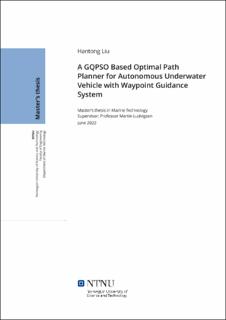| dc.description.abstract | Autonomous underwater vehicle (AUV) has become a popular and important way to do the exploration and exploitation of ocean areas where it's not possible for human to visit such as areas in higher depth. Most of the time, the operation environment of them exists various obstacles, including known static obstacles such as rock structure on seafloor, and unknown dynamic obstacles. Therefore, considering the safe operation condition, the path planning methods with collision avoidance could be seen as the core technology for AUV. This master's thesis presents a literature review introducing the main path planning methods with collision avoidance for AUV applications, including global path planning methods and local path planning methods. By going through all main state-of-the-art path planning methods, a discussion is provided to conclude their advantages and disadvantages. Moreover, further study in Particle Swarm Optimization (PSO) is carried out as well as its modified version Quantum-behaved Particle Swarm Optimization (QPSO) and Gaussian Quantum-behaved Particle Swarm Optimization (G-QPSO). By formulating the path planning problem, a PSO-based optimal path planner is designed using MATLAB. Also, its modified versions with QPSO and G-QPSO algorithms are also designed and deployed using MATLAB. 3 different scenarios are simulated to test the performance of the path planner. The simulation result shows that with well-tuned parameters, PSO-based path planner is qualified for path planning for AUV. But the tuning process is difficult and it is hard to avoid its convergence to local optimal solution. With the modified path planner, the tuning process becomes much easier. The performance and convergence ability to global optimum of QPSO and GQPSO-based path planner are better than that of PSO-based path planner. In conclusion, the GQPSO-based optimal path planner is a high-performance path planner for AUV. | |
